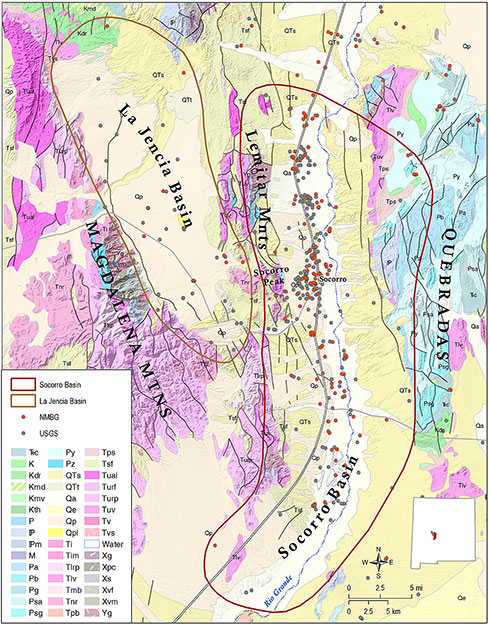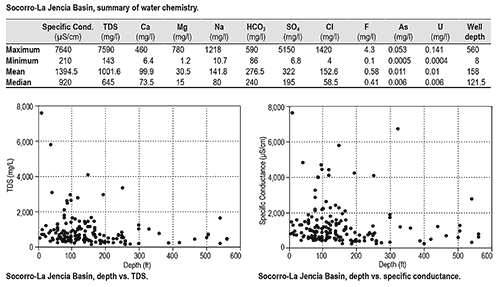
Overview of Fresh and Brackish Water Quality - Socorro-La Jencia Basins


The Socorro and La Jencia Basins are located in Socorro Co., New Mexico, and define a transition where the Rio Grande Rift system broadens into a series of parallel basins separated by intra-rift horst blocks (Chapin, 1971). This broadening represents a general southward increase in crustal extension along the Rio Grande Rift (Adams and Keller, 1994). The Socorro Basin is hydraulically connected to rift basins to the north and south by flow-through drainage of the Rio Grande and southward flow of groundwater through alluvial sediments of the Rio Grande valley. By contrast, the La Jencia Basin has no perennial stream drainage (Anderholm, 1983). The two basins are separated by the Socorro Peak-Lemitar Mountains intra-rift horst, which splits the rift into two semi-parallel halves (Chapin, 1971), and restricts groundwater flow between the basins.
Major water-bearing units in both the Socorro and La Jencia Basins are sands and gravels of the Tertiary-Quaternary Santa Fe Group. That aquifer system can be divided into the Popotosa aquifer, the overlying Popotosa confining bed, and a shallow alluvial aquifer. Other water-bearing zones are contained within fractured Mesozoic-Paleozoic bedrock; Tertiary sandstones, conglomerates and volcaniclastic sediments of the Baca and Datil Formations; and a Tertiary volcanic aquifer system composed of ash-flow tuffs (Anderholm, 1983).
Water quality in the Socorro Basin is highly variable, and is influenced by mixing of regional groundwater inflow from the north with locally-derived irrigation return flow. High chloride concentrations are found in both the northern and southern ends of the Socorro Basin, in some cases up to 50 times greater than chloride concentrations in the central part of the basin. These high chloride concentrations may represent both regional flow of deep basin groundwater from the Albuquerque-Belen Basin to the north, and upward flow of geothermal fluids n the southern part of the basin (Anderholm, 1983).
The combined data set for the Socorro and La Jencia Basins includes 379 records. On a basin-wide scale, the Socorro and La Jencia Basins contain relatively fresh water, with average TDS <1,400 mg/l, and median concentrations of just 920 mg/l. However, a significant percentage of wells in the data set have TDS values between 1,000 and 2,000 mg/l, and thus represent a potential resource of slightly brackish water. Most wells in the two basins are relatively shallow (mean well depth only 158 feet), indicating that the saline portion of the aquifer system is probably under-investigated. Our records also indicate elevated levels of arsenic, with mean concentrations slightly exceeding the EPA MCL of 0.01 mg/l.
This project is funded by the New Mexico Environment Department, Drinking Water Bureau, under Source Water Protection.
For more information:
see: Overview of Regional Brackish Water Assessments
or contact:
Lewis Land — Hydrogeologist, lland@nckri.org
References
- Land, Lewis, 2016, Overview of Fresh and Brackish Water Quality in New Mexico - Socorro-La Jencia Basins, Project Summary Sheet.
- Land, Lewis, 2016, Overview of Fresh and Brackish Water Quality in New Mexico, New Mexico Bureau of Geology Mineral Resources, Open-file Report, v. 0583, pp. 55.



